
A | B | C | D | E | F | G | H | CH | I | J | K | L | M | N | O | P | Q | R | S | T | U | V | W | X | Y | Z | 0 | 1 | 2 | 3 | 4 | 5 | 6 | 7 | 8 | 9
The House of Habsburg (/ˈhæpsbɜːrɡ/, German: Haus Habsburg, pronounced [haʊ̯s ˈhaːpsˌbʊʁk] ⓘ), also known as the House of Austria,[note 6] is one of the most prominent and important dynasties in European history.[3][4]
The house takes its name from Habsburg Castle, a fortress built in the 1020s in present-day Switzerland by Radbot of Klettgau, who named his fortress Habsburg. His grandson Otto II was the first to take the fortress name as his own, adding "Count of Habsburg" to his title. In 1273, Count Radbot's seventh-generation descendant, Rudolph of Habsburg, was elected King of the Romans. Taking advantage of the extinction of the Babenbergs and of his victory over Ottokar II of Bohemia at the Battle on the Marchfeld in 1278, he appointed his sons as Dukes of Austria and moved the family's power base to Vienna, where the Habsburg dynasty gained the name of "House of Austria" and ruled until 1918.
The throne of the Holy Roman Empire was continuously occupied by the Habsburgs from 1440 until their extinction in the male line in 1740, and, as the Habsburg-Lorraines, from 1765 until its dissolution in 1806. The house also produced kings of Bohemia, Hungary, Croatia, Slavonia, Dalmatia, Spain, Portugal, Lombardy-Venetia and Galicia-Lodomeria, with their respective colonies; rulers of several principalities in the Low Countries and Italy; numerous Prince-Bishoprics in the Holy Roman Empire, and in the 19th century, emperors of Austria and of Austria-Hungary, as well as one emperor of Mexico. The family split several times into parallel branches, most consequentially in the mid-16th century between its Spanish and German-Austrian branches following the abdication of Emperor Charles V in 1556. Although they ruled distinct territories, the different branches nevertheless maintained close relations and frequently intermarried.
Members of the Habsburg family oversee the Austrian branch of the Order of the Golden Fleece and the Imperial and Royal Order of Saint George. The current head of the family is Karl von Habsburg.
Name
The origins of Habsburg Castle's name are uncertain. There is disagreement on whether the name is derived from the High German Habichtsburg (hawk castle), or from the Middle High German word hab/hap meaning ford, as there is a river with a ford nearby. The first documented use of the name by the dynasty itself has been traced to the year 1108.[5][6][7]
The Habsburg name was not continuously used by the family members, since they often emphasized their more prestigious princely titles. The dynasty was thus long known as the "House of Austria". Complementarily, in some circumstances the family members were identified by their place of birth. Charles V was known in his youth after his birthplace as Charles of Ghent. When he became king of Spain he was known as Charles of Spain, and after he was elected emperor, as Charles V (in French, Charles Quint).
In Spain, the dynasty was known as the Casa de Austria, including illegitimate sons such as John of Austria and John Joseph of Austria. The arms displayed in their simplest form were those of Austria, which the Habsburgs had made their own, at times impaled with the arms of the Duchy of Burgundy (ancient).
After Maria Theresa married Duke Francis Stephen of Lorraine, the idea of "Habsburg" as associated with ancestral Austrian rulership was used to show that the old dynasty continued as did all its inherited rights. Some younger sons who had no prospects of the throne were given the personal title of "count of Habsburg".
The surname of more recent members of the family such as Otto von Habsburg and Karl von Habsburg is taken to be "von Habsburg" or more completely "von Habsburg-Lothringen". Princes and members of the house use the tripartite arms adopted in the 18th century by Francis Stephen.
The name of the dynasty is sometimes spelled in English publications as Hapsburg.[8][9][10]
History
| History of Austria |
|---|
 |
|
|
Counts of Habsburg
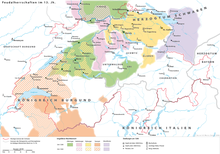
The progenitor of the House of Habsburg may have been Guntram the Rich, a count in the Breisgau who lived in the 10th century, and forthwith farther back as the medieval Adalrich, Duke of Alsace, from the Etichonids from which Habsburg derives. His grandson Radbot of Klettgau founded the Habsburg Castle. That castle was the family seat during most of the 11th, 12th and 13th centuries. Giovanni Thomas Marnavich in his book "Regiae Sanctitatis Illyricanae Faecunditas" dedicated to Ferdinand III, wrote that the House of Habsburg is descended from the Roman emperor Constantine the Great,[11] an invention common in ruling dynasties at the time.
In the 12th century, the Habsburgs became increasingly associated with the Staufer emperors, participating in the imperial court and the emperor's military expeditions; Werner II, Count of Habsburg died fighting for Emperor Frederick I Barbarossa in Italy. This association helped them to inherit many domains as the Staufers caused the extinction of many dynasties, some of which the Habsburgs were heirs to. In 1198, Rudolf II, Count of Habsburg fully dedicated the dynasty to the Staufer cause by joining the Ghibellines and funded the Staufer emperor Frederick II's war for the throne in 1211. The emperor was made godfather to his newly born grandson, the future King Rudolf.[12][13]
The Habsburgs expanded their influence through arranged marriages and by gaining political privileges, especially countship rights in Zürichgau, Aargau and Thurgau. In the 13th century, the house aimed its marriage policy at families in Upper Alsace and Swabia. They were also able to gain high positions in the church hierarchy for their members. Territorially, they often profited from the extinction of other noble families such as the House of Kyburg.[14][15]
Pivot to Eastern Alpine Duchies
By the second half of the 13th century, Count Rudolph I (1218–1291) had become an influential territorial lord in the area between the Vosges Mountains and Lake Constance. On 1 October 1273, he was elected as a compromise candidate as King of the Romans and received the name Rudolph I of Germany.[14] He then led a coalition against King Ottokar II of Bohemia who had taken advantage of the Great Interregnum in order to expand southwards, taking over the respective inheritances of the Babenberg (Austria, Styria, Savinja) and of the Spanheim (Carinthia and Carniola). In 1278, Rudolph and his allies defeated and killed Ottokar at the Battle of Marchfeld, and the lands he had acquired reverted to the German crown. With the Georgenberg Pact of 1286, Rudolph secured for his family the duchies of Austria and Styria. The southern portions of Ottokar's former realm, Carinthia, Carniola, and Savinja, went to Rudolph's allies from the House of Gorizia.[16][17]
Following Rudolph's death in 1291, Albert I's assassination in 1308, and Frederick the Fair's failure to secure the German/Imperial crown for himself, the Habsburgs temporarily lost their supremacy in the Empire. In the early 14th century, they also focused on the Kingdom of Bohemia. After Václav III's death on 4 August 1306, there were no male heirs remaining in the Přemyslid dynasty. Habsburg scion Rudolph I was then elected but only lasted a year. The Bohemian kingship was an elected position,[18] and the Habsburgs were only able to secure it on a hereditary basis much later in 1626, following their reconquest of the Czech lands during the Thirty Years' War. After 1307, subsequent Habsburg attempts to gain the Bohemian crown were frustrated first by Henry of Bohemia (a member of the House of Gorizia) and then by the House of Luxembourg.
Instead, they were able to expand southwards: in 1311, they took over Savinja; after the death of Henry in 1335, they assumed power in Carniola and Carinthia; and in 1369, they succeeded his daughter Margaret in Tyrol. After the death of Albert III of Gorizia in 1374, they gained a foothold at Pazin in central Istria, followed by Trieste in 1382. Meanwhile, the original home territories of the Habsburgs in what is now Switzerland, including the Aargau with Habsburg Castle, were lost in the 14th century to the expanding Swiss Confederacy after the battles of Morgarten (1315) and Sempach (1386). Habsburg Castle itself was finally lost to the Swiss in 1415.
Albertinian / Leopoldian split and Imperial elections
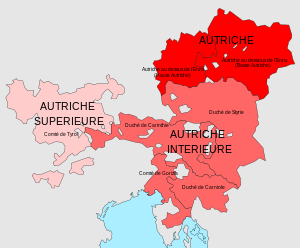
Rudolf IV's brothers Albert III and Leopold III ignored his efforts to preserve the integrity of the family domains and enacted the separation of the so-called Albertinian and Leopoldian family lines on 25 September 1379 by the Treaty of Neuberg. The former would maintain Austria proper (then called Niederösterreich but comprising modern Lower Austria and most of Upper Austria), while the latter would rule over lands then labeled Oberösterreich, namely Inner Austria (Innerösterreich) comprising Styria, Carinthia and Carniola, and Further Austria (Vorderösterreich) consisting of Tyrol and the western Habsburg lands in Alsace and Swabia.[14]
By marrying Elisabeth of Luxembourg, the daughter of Emperor Sigismund, in 1437 Duke Albert V of the Albertine line (1397–1439) became the ruler of Bohemia and Hungary, again expanding the family's political horizons. The next year Albert was crowned King of the Romans, known as such as Albert II. Following his early death in a battle against the Ottomans in 1439 and that of his son Ladislaus Postumus in 1457, the Habsburgs lost Bohemia once more as well as Hungary for several decades. However, with the extinction of the House of Celje in 1456 and the House of Wallsee-Enns in 1466/1483, they managed to absorb significant secular enclaves into their territories and create a contiguous domain stretching from the border with Bohemia to the Adriatic Sea.
After the death of Leopold's eldest son, William, in 1406 the Leopoldian line was further split among his brothers into the Inner Austrian territory under Ernest the Iron and a Tyrolean/Further Austrian line under Frederick of the Empty Pockets. In 1440 Ernest's son Frederick III was chosen by the electoral college to succeed Albert II as the king. Several Habsburg kings had attempted to gain the imperial dignity over the years, but success finally arrived on 19 March 1452, when Pope Nicholas V crowned Frederick III as the Holy Roman Emperor in a grand ceremony held in Rome. In Frederick III the Pope found an important political ally with whose help he was able to counter the conciliar movement.[14]
While in Rome Frederick III married Eleanor of Portugal, enabling him to build a network of connections with dynasties in the west and southeast of Europe. Frederick was rather distant to his family; Eleanor, by contrast, had a great influence on the raising and education of Frederick's children and therefore played an important role in the family's rise to prominence. After Frederick III's coronation the Habsburgs were able to hold the imperial throne almost continuously until 1806.[14]
Archdukes
Through the forged document called privilegium maius (1358/59), Rudolf IV, Duke of Austria (1339–1365) introduced the title of Archduke to place the Habsburgs on a par with the Prince-electors of the Empire, since Emperor Charles IV had omitted to give them the electoral dignity in his Golden Bull of 1356. Charles, however, refused to recognize the title, as did his immediate successors.
Duke Ernest the Iron and his descendants unilaterally assumed the title "archduke". That title was only officially recognized in 1453 by Emperor Frederick III, the ruler of Austria himself.[19] Frederick himself used just "Duke of Austria", never Archduke, until his death in 1493. The title was first granted to Frederick's younger brother, Albert VI of Austria (died 1463), who used it at least from 1458. In 1477, Frederick granted the title archduke to his first cousin Sigismund of Austria, ruler of Further Austria. Frederick's son and heir, the future Maximilian I, Holy Roman Emperor, apparently only started to use the title after the death of his wife Mary of Burgundy in 1482, as Archduke never appears in documents issued jointly by Maximilian and Mary as rulers in the Low Countries (where Maximilian is still titled "Duke of Austria"). The title appears first in documents issued under the joint rule of Maximilian and Philip (his under-age son) in the Low Countries.
Archduke was initially borne by those dynasts who ruled a Habsburg territory, i.e., only by males and their consorts, appanages being commonly distributed to Cadets . These "junior" archdukes did not thereby become independent hereditary rulers, since all territories remained vested in the Austrian crown. Occasionally a territory might be combined with a separate gubernatorial mandate ruled by an archducal cadet. From the 16th century onward, archduke and its female form, archduchess, came to be used by all the members of the House of Habsburg (e.g., Queen Marie Antoinette of France was born Archduchess Maria Antonia of Austria).
Reunification and expansion
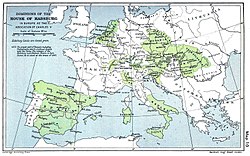
In 1457 Duke Frederick V of Inner Austria also gained the Austrian archduchy after his Albertine cousin Ladislaus the Posthumous had died without issue. 1490 saw the reunification of all Habsburg lines when Archduke Sigismund of Further Austria and Tyrol resigned in favor of Frederick's son Maximilian I.
As emperor, Frederick III took a leading role in the family and positioned himself as the judge over the family's internal conflicts, often making use of the privilegium maius. He was able to restore the unity of the house's Austrian lands, since the Albertinian line was now extinct. Territorial integrity was also strengthened by the extinction of the Tyrolean branch of the Leopoldian line. Frederick's aim was to make Austria a united country stretching from the Rhine to the Mur and Leitha.[14]
Externally, one of Frederick's main achievements was the Siege of Neuss (1474–75), in which he coerced Charles the Bold of Burgundy to give his daughter Mary of Burgundy as wife to Frederick's son Maximilian.[14] The wedding took place on the evening of 16 August 1477 and ultimately resulted in the Habsburgs acquiring control of the Burgundian Netherlands. After Mary's early death in 1482 Maximilian attempted to secure the Burgundian inheritance for one of his and Mary's children Philip the Handsome. Charles VIII of France contested this, using both military and dynastic means, but the Burgundian succession was finally ruled in favor of Philip in the Treaty of Senlis in 1493.[20]
After the death of his father in 1493 Maximilian was proclaimed the new King of Germany, as Maximilian I. Maximilian was initially unable to travel to Rome to receive the Imperial title from the Pope owing to opposition from Venice and from the French who were occupying Milan as well a refusal from the Pope owing to enemy forces being present on his territory. In 1508 Maximilian proclaimed himself to be the 'chosen Emperor', and this was also recognized by the Pope owing to changes in political alliances. This had a historical consequence in that in the future the Roman king would also automatically become emperor without needing the Pope's consent. Emperor Charles V would be the last to be crowned by the Pope himself, at Bologna in 1530.[20]
Maximilian's rule (1493–1519) was a time of dramatic expansion for the Habsburgs. In 1497 Maximilian's son Philip, known as the Handsome or the Fair, married Joanna of Castile, also known as Joanna the Mad, heiress of Castile and Aragon. Phillip and Joan had six children, the eldest of whom became Emperor Charles V in 1516 and ruled the kingdoms of Castile and Aragon (including their colonies in the New World), Southern Italy, Austria and the Habsburg Netherlands with his mother and nominal coruler, Joanna, who was kept under confinement.[21]
The foundations for the later empire of Austria-Hungary were laid in 1515 by a double wedding between Louis, only son of Vladislaus II, King of Bohemia and Hungary, and Maximilian's granddaughter Mary and between her brother Archduke Ferdinand and Louis's sister Anna. The wedding was celebrated in grand style on 22 July 1515. All these children were still minors, so the wedding was formally completed in 1521. Vladislaus died on 13 March 1516 and Maximilian on 12 January 1519, but the latter's designs were ultimately successful: on Louis's death in battle in 1526 Ferdinand became king of Bohemia and Hungary.
The Habsburg dynasty achieved its highest position when Charles V was elected Holy Roman Emperor in 1519. Much of Charles's reign was dedicated to the fight against Protestantism, which led to its eradication throughout vast areas under Habsburg control.
Spanish and Austrian Habsburgs
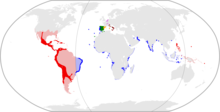

Charles formally became the sole monarch of Spain upon the death of his imprisoned mother Queen Joan in 1555.
After the abdication of Charles V in 1556, the Habsburg dynasty split into the branch of the Austrian (or German) Habsburgs, led by Ferdinand, and the branch of the Spanish Habsburgs, initially led by Charles's son Philip.[22] Ferdinand I, King of Bohemia, Hungary,[23] and archduke of Austria in the name of his brother Charles V became suo jure monarch as well as the Habsburg Holy Roman Emperor (designated as successor already in 1531). Philip became King of Spain and its colonial empire as Philip II, and ruler of the Habsburg domains in Italy and the Low Countries. The Spanish Habsburgs also ruled Portugal for a time, known there as the Philippine dynasty (1580–1640).
The Seventeen Provinces and the Duchy of Milan were in personal union under the King of Spain but remained part of the Holy Roman Empire. Furthermore, the Spanish king had claims on Hungary and Bohemia. In the secret Oñate treaty of 29 July 1617, the Spanish and Austrian Habsburgs settled their mutual claims.
Habsburg inbreeding and extinction of the male lines
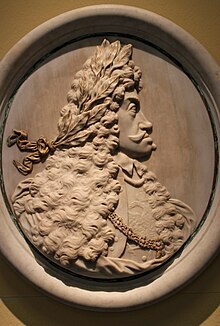
The Habsburgs sought to consolidate their power by frequent consanguineous marriages, resulting in a cumulatively deleterious effect on their gene pool. Health impairments due to inbreeding included epilepsy, insanity and early death. A study of 3,000 family members over 16 generations by the University of Santiago de Compostela suggests inbreeding may have played a role in their extinction.[24] Numerous members of the family showed specific facial deformities: an enlarged lower jaw with an extended chin known as mandibular prognathism or 'Habsburg jaw', a large nose with hump and hanging tip ('Habsburg nose') and an everted lower lip ('Habsburg lip'). The last two are signs of maxillary deficiency. A 2019 study found that the degree of mandibular prognathism in the Habsburg family shows a statistically significant correlation with the degree of inbreeding. A correlation between maxillary deficiency and degree of inbreeding was also present but was not statistically significant.[25][26] Other scientific studies, however, dispute the ideas of any linkage between fertility and consanguinity.[27]
The gene pool eventually became so small that the last of the Spanish line, Charles II, who was severely disabled from birth (perhaps by genetic disorders), possessed a genome comparable to that of a child born to a brother and sister, as did his father, probably because of 'remote inbreeding'.[28][24]
The death of Charles II of Spain in 1700 led to the War of the Spanish Succession and that of Emperor Charles VI in 1740 to the War of the Austrian Succession. The former was won by House of Bourbon, putting an end to Habsburg rule in Spain. The latter, however, was won by Maria Theresa and led to the succession of the House of Habsburg-Lorraine (German: Haus Habsburg-Lothringen) becoming the new main branch of the dynasty in the person of Maria Theresa's son, Joseph II. This new House was created by the marriage between Maria Theresa and Francis Stephan, Duke of Lorraine.[29] (Both of them were great-grandchildren of Habsburg emperor Ferdinand III, but from different empresses.) This new House was a cadet branch of the female line of the House of Habsburg and the male line of the House of Lorraine.
House of Habsburg-Lorraine
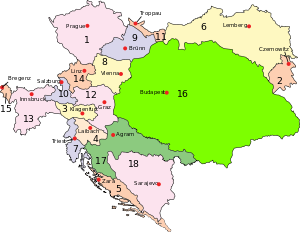 Kingdoms and countries of Austria-Hungary: Cisleithania (Empire of Austria[30]): 1. Bohemia, 2. Bukovina, 3. Carinthia, 4. Carniola, 5. Dalmatia, 6. Galicia, 7. Küstenland, 8. Lower Austria, 9. Moravia, 10. Salzburg, 11. Silesia, 12. Styria, 13. Tyrol, 14. Upper Austria, 15. Vorarlberg; Transleithania (Kingdom of Hungary[30]): 16. Hungary proper 17. Croatia-Slavonia; 18. Bosnia and Herzegovina (Austro-Hungarian condominium) |
On 6 August 1806, Emperor Francis I dissolved the Holy Roman Empire under pressure from Napoleon's reorganization of Germany. In anticipation of the loss of his title of Holy Roman Emperor, Francis had declared himself hereditary Emperor of Austria (as Francis I) on 11 August 1804, three months after Napoleon had declared himself Emperor of the French on 18 May 1804.
Emperor Francis I of Austria used the official full list of titles: "We, Francis the First, by the grace of God, Emperor of Austria; King of Jerusalem, Hungary, Bohemia, Dalmatia, Croatia, Slavonia, Galicia and Lodomeria; Archduke of Austria; Duke of Lorraine, Salzburg, Würzburg, Franconia, Styria, Carinthia, and Carniola; Grand Duke of Cracow; Grand Prince of Transylvania; Margrave of Moravia; Duke of Sandomir, Masovia, Lublin, Upper and Lower Silesia, Auschwitz and Zator, Teschen, and Friule; Prince of Berchtesgaden and Mergentheim; Princely Count of Habsburg, Gorizia and Gradisca and of the Tyrol; and Margrave of Upper and Lower Lusatia and Istria".
The Austro-Hungarian Compromise of 1867 created a real union, whereby the Kingdom of Hungary was granted co-equality with the Empire of Austria, that henceforth didn't include the Kingdom of Hungary as a crownland anymore. The Austrian and the Hungarian lands became independent entities enjoying equal status.[31] Under this arrangement, the Hungarians referred to their ruler as king and never emperor (see k. u. k.). This prevailed until the Habsburgs' deposition from both Austria and Hungary in 1918 following defeat in World War I.

On 11 November 1918, with his empire collapsing around him, the last Habsburg ruler, Charles I of Austria (who also reigned as Charles IV of Hungary) issued a proclamation recognizing Austria's right to determine the future of the state and renouncing any role in state affairs. Two days later, he issued a separate proclamation for Hungary. Even though he did not officially abdicate, this is considered the end of the Habsburg dynasty.
In 1919, the new republican Austrian government subsequently passed a law banishing the Habsburgs from Austrian territory until they renounced all intentions of regaining the throne and accepted the status of private citizens. Charles made several attempts to regain the throne of Hungary, and in 1921 the Hungarian government passed a law that revoked Charles' rights and dethroned the Habsburgs, although Hungary remained a kingdom, albeit without a king, until 1946. The Habsburgs did not formally abandon all hope of returning to power until Otto von Habsburg, the eldest son of Charles I, on 31 May 1961 renounced all claims to the throne.
In the interwar period, the House of Habsburg was a vehement opponent of Nazism and Communism. In Germany, Adolf Hitler diametrically opposed the centuries-old Habsburg principles of largely allowing local communities under their rule to maintain traditional ethnic, religious and language practices, and he bristled with hatred against the Habsburg family.[32] During the Second World War there was a strong Habsburg resistance movement in Central Europe, which was radically persecuted by the Nazis and the Gestapo. The unofficial leader of these groups was Otto von Habsburg, who campaigned against the Nazis and for a free Central Europe in France and the United States. Most of the resistance fighters, such as Heinrich Maier, who successfully passed on production sites and plans for V-2 rockets, Tiger tanks and aircraft to the Allies, were executed. The Habsburg family played a leading role in the fall of the Iron Curtain and the collapse of the Communist Eastern Bloc.[33][34][35][36][37]
Zdroj:https://en.wikipedia.org?pojem=House_of_HabsburgText je dostupný za podmienok Creative Commons Attribution/Share-Alike License 3.0 Unported; prípadne za ďalších podmienok. Podrobnejšie informácie nájdete na stránke Podmienky použitia.
Antropológia
Aplikované vedy
Bibliometria
Dejiny vedy
Encyklopédie
Filozofia vedy
Forenzné vedy
Humanitné vedy
Knižničná veda
Kryogenika
Kryptológia
Kulturológia
Literárna veda
Medzidisciplinárne oblasti
Metódy kvantitatívnej analýzy
Metavedy
Metodika
Text je dostupný za podmienok Creative
Commons Attribution/Share-Alike License 3.0 Unported; prípadne za ďalších
podmienok.
Podrobnejšie informácie nájdete na stránke Podmienky
použitia.
www.astronomia.sk | www.biologia.sk | www.botanika.sk | www.dejiny.sk | www.economy.sk | www.elektrotechnika.sk | www.estetika.sk | www.farmakologia.sk | www.filozofia.sk | Fyzika | www.futurologia.sk | www.genetika.sk | www.chemia.sk | www.lingvistika.sk | www.politologia.sk | www.psychologia.sk | www.sexuologia.sk | www.sociologia.sk | www.veda.sk I www.zoologia.sk


